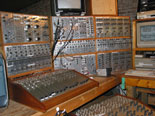Data sheet (Research project):
| Documenting electronic art: "Capturing Unstable Media" |
| Title of research project Capturing Unstable Media |
| Location of research project V2_, Institute for the Unstable Media, Rotterdam, The Netherlands |
| Participation method Commentaire |
| Theme 2- Documentation of media art |
Observer: Mélanie Avice |
Between March and December 2003, the V2 archives group (V2_Archive) led a research project entitled Capturing Unstable Media. The project was conducted in the V2_Organization, a centre for culture and technology located in Rotterdam (The Netherlands), and focused on various aspects of documenting electronic art activities within a perspective of archiving and preservation. Capturing Unstable Media, supported by the Mondriaan Foundation and the Daniel Langlois Foundation for Art, Science and Technology, was overseen by an advisory board of researchers and information science and conservation specialists from the Maastricht McLuhan Institute, Netherlands Media Art Institute, de Balie, Filmmuseum, Netherlands Institute for Sound and Vision, and the National Library of the Netherlands. As part of the project, two case studies were conducted on Whisper (Kozel, Susan; Schiphorst, Thecla, 2002) and DataCloud 2.0 (Handstede, Maarten; Lichtenegger, Brigit; Neelan, Marc; Nigten, Anne; Verhoog, Lenno; Vollaard, Piet; 2001-2002). These case studies led to a series of recommendations on documentation strategies associated with the activities surrounding electronic art, formal modeling, metadata, and archival interoperability. The Capturing Unstable Media Web site provides extensive information on the project. By clicking on the summary of research menu, Internet users will find texts on the research context and results and archival interoperability. The texts put forward a number of affirmations, a few of which are presented below: a) The inventory of documentation and preservation practices for various institutions that conserve electronic art was the result of extensive research, often conducted by a team of artists, scientists, engineers and designers. b) Institutions must define a level of depth for each of the documentation projects as well as the steps, versions and components to be documented. In addition, a series of electronic art characteristics must be considered during the documentation process: “(1) electronic art activities are process-based; (2) context is very important; (3) the activities are heterogeneous in materials and practices; (4) projects are usually created through interdisciplinary or multidisciplinary collaboration; (5) user interaction is an essential activity in the dissemination phase of many projects; (6) it is important to speak about electronic art activities, and not just artworks; (7) preserving and reconstructing objects becomes less relevant than in contemporary art preservation.” c) The case studies proved that information regarding the documentation of a project is often dispersed institutionally or geographically. Nevertheless, the research project defined certain starting points in the establishment of interoperability among the various archival systems, as some concepts (actors, a list of terms and key words from a thesaurus, concepts in describing the projects, the works of art and/or the activities and technical specifications) recur through various data models. |
Links: http://capturing.projects.v2.nl/ Capturing Unstable Media Web site [On-line] (Page consulted October 20, 2005) |


